18개월~만 2세 유아들의 성장 발육. Growth and development of 18 month~2 year old toddlers
18개월~만 2세 유아들의 성장
표 3-24.18개월 한국 유아들의 체중과 신장의 백분위수
|
백분위 수
성별 |
3 | 10 | 25 | 50 | 75 | 90 | 97 | |
| 남아 | 체중(kg) | 8.02 | 9.00 | 9.70 | 10.30 | 11.40 | 12.50 | 13.40 |
| 남아신장(cm) | 72.0 | 76.0 | 76.5 | 80.2 | 82.5 | 85.0 | 92.8 | |
| 여아 | 체중(kg) | 7.75 | 8.70 | 9.30 | 10.00 | 11.00 | 12.00 | 13.00 |
| 여아신장(cm) | 70.6 | 74.5 | 77.0 | 79.5 | 81.8 | 84.5 | 89.0 |
표 3-25. 21개월 한국 유아들의 체중과 신장의 백분위수
|
백분위 수
성별 |
3 | 10 | 25 | 50 | 75 | 90 | 97 | |
| 남아 | 체중(kg) | 8.35 | 9.20 | 9.85 | 10.70 | 11.50 | 12.50 | 13.80 |
| 남아신장(cm) | 73.5 | 76.4 | 79.4 | 82.0 | 85.1 | 88.0 | 93.5 | |
| 여아 | 체중(kg) | 7.80 | 8.90 | 9.50 | 10.30 | 11.30 | 12.10 | 13.20 |
| 여아신장(cm) | 71.0 | 75.6 | 78.7 | 80.9 | 83.4 | 86.6 | 91.5 |
그림 3-137. 0~3세 한국 남 신생아, 남 영유아들의 성장차트와 백분위선.
Copyright ⓒ 2012 John Sangwon Lee, MD., FAAP
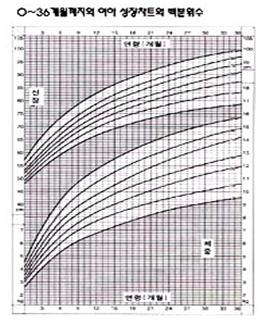
그림 3-138. 0~3세 한국 여 신생아, 여 영유아들의 성장차트와 백분위선. Copyright ⓒ 2012 John Sangwon Lee, MD., FAAP
- 유아의 체중과 신장을 잰 다음 체중 치와 신장 치를 성장차트 체중·신장 백분위선에 그린다. 그 유아의 체중과 신장이 성장차트 체중·신장 백분위선 상 어디에 있는지 알아본다.
- 그 유아의 체중과 신장이 성장차트 체중·신장 백분위선을 따라 전과 같은 성장 속도로 계속 증가하면서 정상적으로 잘 자라고 있나 알아본다.
| 소아청소년 예측 체중신장주기와 소아청소년 예측 체중 신장 계산공식 참조 |
- 이 시기의 대부분의 유아들의 체중과 신장의 성장 속도가 정상적으로 느린 것이 보통이다.
- 그러나 체중과 신장을 몇 개월마다 재고 체중 치와 신장 치를 성장차트 체중·신장 백분위선에 그려보면 체중과 신장이 정상적으로 서서히 계속 증가되고 있는 것을 알 수 있다.
- 이 시기 대부분의 유아들의 머리의 앞부분 중앙 부위에 있던 대천문이 완전히 막힌다.
| 생후 18~ 24개월까지 소아 정기 건강검진 시 자폐증 스펙트럼 장애가 있는지 체크한다. |
|
■ 생후 18개월부터 24개월까지 소아 건강검진을 받을 때 자폐증 스펙트럼 장애가 있는지 지속적으로 체크한다.
|
18개월~만 2세 유아들의 발육
1. 18개월~만 2세 유아들의 신체 발육
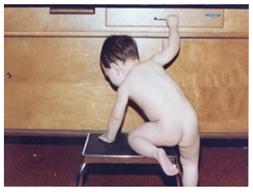
사진 3-139. 책상이나 식탁 등 높은 데 있는 것을 갖고 싶으면 의자 등을 끌어다놓고 그 위에 올라가서 가지려고 애쓴다.
Copyright ⓒ 2012 John Sangwon Lee, MD., FAAP
- 부모의 도움 없이 혼자서 제법 잘 걷고 뛰어다닐 수 있고 계단을 전보다 쉽게 오르고 내릴 수 있다.
- 빙글빙글 돌 수 있다.
- 이때의 대부분의 유아들은 전보다 두 다리와 두 팔을 앞뒤로 쭉쭉 뻗치면서 잘 걸을 수 있다.
- 아직도 손, 발, 팔다리, 몸통 등이 조화 있게 잘 움직이지 못한다.
- 물건을 전보다 더 힘껏 끌고 당기고 밀고 던질 수 있다.
- 주먹으로 무엇을 칠 수 있다.
- 책상 위나 식탁 위 등 높은 데 올려놓은 물건을 갖고 싶으면 의자 등을 끌어다 놓고 그 위에 올라가 물건을 내려놓으려고 한다.
2. 18개월~만 2세 유아들의 손 발육
- 18개월 된 유아들의 대부분은 수저, 포크, 또는 손으로 음식물을 제법 잘 먹을 수 있다.
- 자기 혼자서 장갑, 모자, 또는 신발을 벗을 수 있다.
- 문을 열고 닫을 수 있다.
- 변기의 물 꼭지를 틀어 변기 속 대소변을 변기 속 물로 씻을 수 있다.
- 세 개의 장난감 정육면체 블록을 위아래로 차곡차곡 쌓을 수 있다.
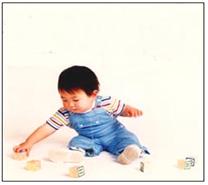
사진 3-140. 정육면체 블록으로 탑을 위아래로 쌓을 때 칭찬하면 좋아한다.
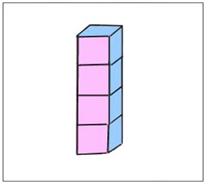
Copyright ⓒ 2012 John Sangwon Lee, MD., FAAP
그림 3-141.생후 15~24개월 된 유아들의 대부분은 정육면체 블록으로 탑을 쌓을 수 있다.
Copyright ⓒ 2012 John Sangwon Lee, MD, FAAP
3. 18개월~만 2세 유아들의 언어 발육
- ‘그것’ 또는 ‘나’ 등의 대명사를 써서 말할 수 있다.
- 예를 들면, 책을 ‘채’로 발음하는 것같이 받침을 빼놓고 발음하는 유아들도 있다.
- ‘앞에’, ‘뒤에’ , 또는 ‘위에’ 등 방향 부사를 써서 말할 수 있다.
- 자기가 표현하고 싶은 뜻을 다른 사람들에게 정확히 표현해서 전달할 수 없을 때 화내고 울기도 한다.
4. 18개월~만 2세 유아들의 사회성 발육
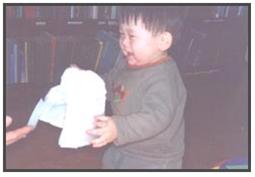
사진 3-142. 간단한 심부름을 할 수 있다.
Copyright ⓒ 2012 John Sangwon Lee, MD., FAAP
- 이 시기의 대부분의 유아들은 부모로부터 전보다 더 독립을 추구하려고 노력한다.
- 자기 주위에 있는 사물에 관해서 전보다 더 관심과 흥미를 갖고, 집안에서 생기는 일에 참여하려고 한다.
- 부모가 어떤 물건을 어디에다 놓는지 잘 관찰했다가 나중에 찾아내기도 한다.
- 주위에서 일어나는 새롭고 신기로운 것에 흥미를 갖는다.
- 게임의 규칙을 잘 이해하지도 못하면서 누나 형과 같이 게임하고 싶어 한다.
- 부모나 형제자매들과 함께 장난감 정육면체 블록을 가지고 놀기를 좋아한다.
- 자기가 장난감 육면체 블록으로 만든 다리나 쌓아 올린 탑에 대해 잘했다고 칭찬받으면 좋아한다. ( “생후 1개월~6세의 영유아들의 발육 이정표” 참조.)
| 이런 경우에는 유아 발육지연을 의심해 본다 |
참조
| 18개월~만 2세 유아들의 장난감 |
장난감 참조
| 18개월~만 2세 유아들의 영양 |
- 이 시기의 대부분의 유아들의 성장 속도는 정상적으로 느린 편이다.
- 그에 따라 음식물의 섭취양도 많지 않고 조금씩 먹는 것같이 보인다.
- 이런 음식물 섭취 패턴의 거의가 정상적이다.
- 그러나 걱정되면 소아청소년과에 문의 상담한다.
- 식구들과 같이 밥을 먹을 때 때로는 오래 걸려 먹기도 하고, 여러 가지 음식물을 한 그릇에 섞어 놓고 아예 먹어 보지도 않고 그대로 버리기도 한다.
- 부모나 식구들과 함께 주식을 하루에 세 번, 주식과 주식 사이사이에 간식을 두 번 먹는다.
| 18개월~만 2세 유아들의 양호 |
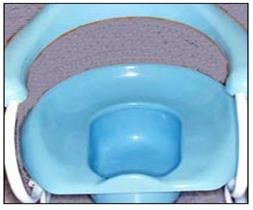
사진 3-143. 유아용 변기로 배변 훈련을 시킬 수 있다. 대소변을 보라고 강요해선 절대로 안 된다.
Copyright ⓒ 2012 John Sangwon Lee, MD., FAAP
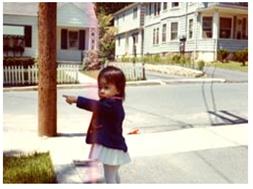
사진 3-144. 교통사고, 화상사고, 추락사고, 약물중 독사고, 독극물 중독사고 또는 화학물질중독 사고, 질식 사고나 교통사고 등 안전사고가 생기지 않도록 각별히 주의한다.
Copyright ⓒ 2012 John Sangwon Lee, MD., FAAP
- 발육이 빠른 생후 18∼21개월 유아들의 일부는 대소변을 가릴 수 있다.
- 그러나 생후18~2세 유아들의 대부분은 대소변을 완전히 가리지 못한다.
- 대소변 가리기 훈련을 성장발육 성숙도에 따라 적절히 시켜야 한다.
- 대소변이 마렵다고 말을 한 다음 유아용 변기에 대소변을 보는 유아들도 있고, 대소변을 싸지 않고 변기에 배변을 한 것을 자랑스럽게 생각하는 유아들도 있다.
- 바로 이렇게 배변을 가리려고 하는 유아들에게 대소변 가리기 훈련을 시키면 대소변을 쉽게 가릴 수 있다.
- 화상 사고, 추락사고, 약물중독 사고, 독극물 중독사고, 또는 화학물질 중독사고, 질식사고, 교통사고 등 안전사고가 나지 않도록 각별히 주의해야 한다.
- 생후 18개월경 정기 건강검진을 하고 권장한 소아청소년 예방접종스케줄에 따라 예방 접종을 다 받지 않았으면 따라 잡기 예방 접종 표([부모도 반의사가 되어야 한다-소아가정간호백과]-제 2권 소아청소년 질병 안전사고 예방)에 의해 해준다.
- 필요에 따라 빈혈 검사, 납중독 혈액검사, 소변검사를 한다.
- 다음 정기 건강검진은 2세경에 한다.
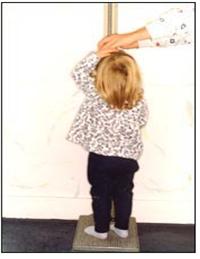
사진 3-145. 정기 건강검진을 받을 때 정상적으로 자라나 알아보기 위해 신장을 잰다.
Copyright ⓒ 2012 John Sangwon Lee, MD., FAAP
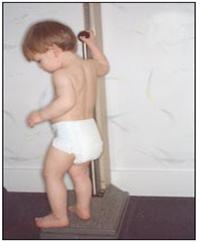
사진 3-146. 정기 건강검진을 받을 때 정상적으로 자라나 알아보기 위해 체중을 잰다.
Copyright ⓒ 2012 John Sangwon Lee, MD., FAAP
|
다음은“사랑, 잠, 분노, 아이가 잠투정이 심하고 악을 써요”에 관한 인터넷 소아청소년 건강상담 질의응답의 예 입니다. |
Q&A. 사랑, 잠, 분노, 아이가 잠투정이 심하고 악을 써요
Q.
- 안녕하세요. 더운 날씨에 고생 많으십니다.
- 다름이 아니라 저의 아이는 여아이구요 지금 21개월 반입니다. 그런데 3개월 전부터 제가 직장에 나가서 친정에 맡기고 있습니다. (오전에는 외할머니, 이모(9개월 된 아들이 있음)가 보고 오후에는 이모가 돌봄) 저녁에 퇴근해서는 제가 집으로 데리고 옵니다.
- 그런데 약 한 달 전부터는 낮잠 잘 때는 물론이고 밤에도 잠이 오면서도 자지 않고 신경질에다 짜증에다 그것도 안 되면 악을 쓰며 울고불고 난리가 납니다. 그러다가 울다 잠들기도 하고 업고 재우기도 하고 그냥 잘 때도 있지만 잠재우기가 힘듭니다.
- 평균수면시간은 (낮잠포함)약 9시간에서11시간정도입니다.
- 그리고 깨어 있을 동안에도 뭐가 그리 불만인지 조금만 맘에 안 들면 온갖 트집을 잡으며 울고 악을 씁니다. 그래서 안고 달래면 좀 나아지고 “왜 그러는지 말을 해야지“라고 말하면서 눈을 마주보려고 그러면 악을 쓰며 울며 매달립니다. 이럴 때는 계속 안아주고 달래줘야 되는지, 자꾸 그러면 안 될 것 같아 안아주지 않고 방관하고 있으면 자지러지면서 울고불고 매달리고 난리가 납니다. 이럴 때는 어떻게 대처해야 하는지 매우 난감합니다.
- 도움 바랍니다. 수고 하세요.
A.
- 원숙님
- 안녕하십니까. 질문해 주셔서 감사합니다.
- 자녀의 나이와 성별, 과거 현재 가족의 병력, 증상 징후와 진찰소견, 적절한 임상검사 등의 결과를 종합해서 진단 치료하는 것이 이상적이지만 주신 정보를 참작해서 답변을 드립니다.
- 자녀가 상당히 혼동된 것 같습니다. 자녀는 자기의 안정된 보금자리와 평화스러운 마음이 깨졌다고 생각하는 것 같습니다.
- 자기에게 가장 필요한 엄마가 자기 곁에 있지 않고 어디로 매일 사라지는 이유를 아기는 이해할 수도 없고 사랑하는 엄마를 영 잃어버린 줄로 잘 못 알고 불안하고 심지어는 분리공포증에 빠진 것 같습니다.
- 아기 자녀가 가장 필요로 하는 것은 돈도 아니고 명예도 아니고 장난감도 아니고 이모도 아니고 할머니도 아닙니다.
- 바로 엄마와 아빠입니다.
- 부모의 조건 없는 진정한 사랑과 보살핌입니다.
- 아기 자녀에게는 엄마의 눈길 접촉사랑과 신체적 접촉사랑이 무엇 보다 더 필요합니다.
- 엄마로부터 받은 사랑으로 채웠던 아기 자녀의 사랑 탱크 속이 텅 비면 그런 현상이 생길 수 있습니다.
- 아기 자녀의 사랑 탱크 속을 엄마의 눈길 접촉사랑과 신체적 접촉사랑 그리고 그와 함께 있으면서 그를 보살펴주면서 집중적 관심적 사랑과 보살핌으로 채워주어야 합니다.
- 그런데 엄마가 일을 하러 갈 때 자기의 사랑 탱크 속을 채워줬던 엄마가 없으니 그의 사랑 탱크는 텅 비어집니다.
- 그런데 그런 사랑과 보살핌을 엄마로부터 더 이상 받을 수 없다고 생각할 때 아기 자녀는 얼마나 낙심하고 화가 나겠습니까.
- 그런 화를 표출하는 하나의 방법으로 울고불고 악을 쓰고 매달리고 잠을 못 자고 분노를 공격적 행동으로 표출하는 것입니다.
- 이러한 공격적 행동 분노 표출 방법은 오늘날 많은 신생아들, 영유아들, 학령기 아이들, 사춘기 아이들에게 나타납니다.
- 약 10만 명의 뻐꾸기 아이들이 있다는 뉴스를 읽었습니다. 큰일입니다.
- 엄마나 아빠가 자기 곁에 있지 않고 자기를 사랑해주지 않기 때문에 화가 나서 생기는 흔한 정상적인 반응입니다.
- 어린 영유아들에게 가장 필요한 것이 무엇인지 아시지요.
- 돈도 아니고 명예도 아니고 기업도 아닙니다. 부모의 사랑입니다.
- 어떤 영유아는 거의 같은 상황에 처했을 때 말도 하지 않고 울지도 않고 먹지도 않고 그 동안 가렸던 대소변을 싸고 부모의 눈길과 자기 눈길을 맞추지도 않는 퇴행성 행동으로 수동적 공격적 행동으로 화를 표출할 수 있습니다.
- 영유아 자녀가 엄마아빠를 쳐다보지 않는다고 한번 생각 해 보셔요.
- 부부간에 서로 쳐다보지도 않는 다고 생각 해 보셔요.
- 이 두 경우 분노를 표출하는 방법이 서로 다른 것을 아실 줄 압니다.
- 하나는 공격적 행동으로 화를 겉으로 나타나게 표출했고 다른 하나는 수동적 공격적 행동으로 분노를 마음속 깊이 안에서 나타냈습니다.
- 즉 분노 표출 방법이 다릅니다. 그러나 이 두 가지 분노의 표출 방법은 흔히 볼 수 있는 분노표출 방법이라고 할 수 있습니다.
- 이 때 부모가 대처해주어야 할 것은 무엇입니까.
- 그들이 필요로 하는 조건 없는 진정한 사랑입니다.
- 그 사랑을 어떻게 전달합니까.
- 눈길 접촉사랑으로 신체적 접촉사랑으로 집중적 사랑과 보살핌으로 그들을 사랑해서 그들에게 부모의 사랑을 전달해야 합니다.
- 자녀가 어디가 아픈 데가 있나 없나 알아보아야 합니다.
- 배가 고픈지 알아보아야 합니다.
- 부모 자신이 영적으로 정서적으로 경제적으로 건전한가도 평가 해보고 알아보아야 합니다.
- 또 그 동안의 부모와 자녀와의 관계가 긍정적으로 좋았었는지 어떠했는지도 알아보아야 합니다.
- 여기서 우리 부모들은 그 아기가 필수적으로 필요한 것, 의, 식, 주, 건강, 잠, 사랑, 장난 감 등을 만족시켜 주고 있는지 재고해 보아야 합니다.
- 그 자녀는 부모의 진정한 사랑을 충분히 받기를 원하는 것이고 부모는 그 자녀가 원하는 조건 없는 진정한 사랑을 충분히 채워 주어야 할 의무가 있습니다.
- 또한 한편으로 오늘날 많은 젊은 부모들은 현 실정에 적응하면서 살아가야 하는 두 갈래 입장에 처해 있습니다.
- 때문에 부모들이 조건 없는 진정한 사랑을 자녀들에게 충분히 해줄 수 없는 경우가 많습니다. 많은 부모들은 가정에 24시간 동안 머무르면서 자녀들에게 필요한 부모노릇을 다 하기가 어렵습니다.
- 바로 이런 것은 오늘날 세계 각처 젊은 부모들이 겪어야 하는 어려움들 중 하나입니다.
- 두서없이 이렇게 드린 말씀드립니다. 사랑, 잠. [부모도 반의사가 되어야 한다–소아가정간호백과]-제 3권 신생아, 영유아, 학령기아 사춘기아 성장 발육 육아–해당 연령의 성장발육 등을 참조하시기 바랍니다. 소아청소년과 전문의의 진단 치료를 받으시기 바랍니다.
- 질문이 더 있으시면 다시 연락해 주시기 바랍니다. 감사합니다. 이상원 드림
Growth and development of 18 month~2-year-old toddlers
Growth of children aged 18 months to 2 years
Table 3-24.18-month-old Korean toddlers weight and height percentiles percentile
표 3-24.18개월 한국 유아들의 체중과 신장의 백분위수
|
percentile
Gender |
3 | 10 | 25 | 50 | 75 | 90 | 97 | |
| boy | weight(kg) | 8.02 | 9.00 | 9.70 | 10.30 | 11.40 | 12.50 | 13.40 |
| height(cm) | 72.0 | 76.0 | 76.5 | 80.2 | 82.5 | 85.0 | 92.8 | |
| girl | weight(kg) | 7.75 | 8.70 | 9.30 | 10.00 | 11.00 | 12.00 | 13.00 |
| height(cm) | 70.6 | 74.5 | 77.0 | 79.5 | 81.8 | 84.5 | 89.0 |
Table 3-25.Percentiles of weight and height for 21-month-old Korean toddlers percentile
|
percentile
Gender |
3 | 10 | 25 | 50 | 75 | 90 | 97 | |
| boy | weight(kg) | 8.35 | 9.20 | 9.85 | 10.70 | 11.50 | 12.50 | 13.80 |
| height(cm) | 73.5 | 76.4 | 79.4 | 82.0 | 85.1 | 88.0 | 93.5 | |
| girl | weight(kg) | 7.80 | 8.90 | 9.50 | 10.30 | 11.30 | 12.10 | 13.20 |
| height(cm) | 71.0 | 75.6 | 78.7 | 80.9 | 83.4 | 86.6 | 91.5 |
Figure 3-137. Growth charts and percentiles of 0-3 years old Korean male newborns and male infants. Copyright ⓒ 2012 John Sangwon Lee, MD., FAAP

Figure 3-138. Growth charts and percentiles of 0-3 years old Korean female infants and toddlers. Copyright ⓒ 2012 John Sangwon Lee, MD., FAAP
• After measuring the toddler’s weight and height, draw the weight and height values on the growth chart weight and height percentiles. Find out where the infant’s weight and height are on the growth chart’s weight and height percentiles.
• Check if the toddler’s weight and height are growing normally while continuing to increase at the same growth rate as before along the weight and height percentiles of the growth chart.
Refer to the weight-growth cycle predicted for children and adolescents and the formula for the predicted weight and height for children and adolescents.
• It is normal for most toddlers at this age to grow normally in weight and height.
• However, if you measure a toddler’s weight and height every few months and plot the weight and height values on the weight and height percentiles of the growth chart, you can see that the weight and height are gradually increasing normally.
• In most toddlers at this age, the anterior fontanel in the anterior central region of the head is completely close. Toddlers from 18 to 24 months of age are checked for autism spectrum disorders during regular health checkups.
From 18 to 24 months of age, when toddlers receive health check-ups, they are constantly checked for autism spectrum disorders.
• 1 in 50 toddlers in the United States has an autism spectrum disorder.
• Therefore, the American Academy of Pediatrics recommends that toddlers at 18 to 24 months of age be screened for autism spectrum disorder.
o In particular, if a sibling has an autism spectrum disorder,
o suspect that the child being screened has an autism spectrum disorder;
o The toddler’s parent or guardian suspects that the infant may have an autism spectrum disorder;
o If the doctor suspects that the child has an autism spectrum disorder
• It is recommended that toddlers be screened for autism using the Modified Checklist for Autism in Toddlers (M-CHAT). sources and references; Pediatrics News. November 2009, p.13
Development of toddlers between 18 months and 2 years of age
1. Physical development of toddler children aged 18 months to 2 years old

Picture 3-139. If toddlers want something on a high place, such as a desk or table, toddlers drag a chair and try to get it on top of it. Copyright ⓒ 2012 John Sangwon Lee, MD., FAAP
• Toddlers can walk and run fairly well on their own without the help of a parent, and climb and descend stairs more easily than before.
• Can spin round and round.
• Most toddlers at this time can walk better than before, with their legs and arms outstretched back and forth.
• Toddlers still have trouble moving my hands, feet, limbs, torso, etc. in harmony.
• Can pull, pull, push, and throw objects with greater force than ever before.
• What toddlers can hit with their fist.
• If toddlers want to have an object placed on a high place, such as on a desk or table, drag a chair, etc., and then climb onto it and put it down.
2. Hand development of children aged 18 months to 2 years old
• Most 18-month-olds can eat fairly well with a spoon, fork, or hand.
• Able to take off gloves, hats, or shoes by yourself.
• Doors can be opened and closed.
• Turn on the toilet’s faucet to flush the toilet with water.
• Three toy cube blocks can be stacked on top of each other.

Picture 3-140. The toddler likes it when he compliments him when he builds a tower up and down with cube blocks. Copyright ⓒ 2012 John Sangwon Lee, MD., FAAP

Figure 3-141. Most toddlers aged 15-24 months can build towers from cube blocks. Copyright ⓒ 2012 John Sangwon Lee, MD, FAAP
3. Language development of toddler children aged 18 months to 2 years old
• You can speak using pronouns such as ‘it’ or ‘me’.
• For example, some children pronounce books without support, such as ‘chae’.
• Toddlers can speak with directional adverbs such as ‘before’, ‘behind’, or ‘above’. • I get angry and cry when I can’t express and convey exactly what I want to express to others.
4. Social development of toddler children aged 18 months to 2 years old

Picture 3-142. Can do simple errands. Copyright ⓒ 2012 John Sangwon Lee, MD., FAAP
• Most toddlers at this age are more likely to seek independence from their parents than ever before.
• They are more interested in things around them than before, and they try to participate in what is happening at home.
• Observe where parents put things, and then find out later.
• Be interested in new and novel things happening around you.
• Toddlers wants to play with his older brother without understanding the rules of the game.
• Likes to play with toy cube blocks with parents and siblings.
• Likes to be praised for doing a good job on a bridge or tower built out of toy hexahedron blocks. (See “Developmental Milestones for Infants 1 Month to 6 Years Old”.) In this case,
Suspect that there is a developmental delay in the toddlers.
Reference
Toys for children 18 months to 2 years old- toy reference
Nutrition for toddlers 18 months to 2 years old
• Most toddlers at this age grow normally slowly.
• As a result, the amount of food intake is not large and it seems to be eating little by little.
• Most of these food intake patterns are normal.
• However, if you are concerned, consult with the Pediatricians.
• When eating with family and friends, it sometimes takes a long time to eat, and sometimes they mix various foods in one bowl and throw it away without even trying it at all.
• Eat three meals a day with a parent or family member and two snacks between stocks.
Good care and parenting for toddler children aged 18 months to 2 years old

Picture 3-143. Potty training can be done with a baby potty. Never force yourself to urinate. Copyright ⓒ 2012 John Sangwon Lee, MD., FAAP

Picture 3-144. Take special care to prevent safety accidents such as traffic accidents, burn accidents, fall accidents, drug poisoning accidents, poisoning accidents or chemical poisoning accidents, suffocation accidents, or traffic accidents. Copyright ⓒ 2012 John Sangwon Lee, MD., FAAP
• Some toddlers aged 18 to 21 months, who are developing rapidly, may have toilet training.
• However, most of the 18-2-year-olds do not have complete toilet training.
• Training for toilet for urine and feces should be performed appropriately according to the level of growth and development maturity.
Some toddlers urinate in the potty after they say they need to urinate. Others are proud of having pooped without urinating.
• If you train infants and toddlers who are trying to cover up their bowel movements in this way, they can easily cover their bowels.
• Special care must be taken to prevent safety accidents such as burn accidents, fall accidents, drug poisoning accidents, poisoning accidents, chemical poisoning accidents, suffocation accidents, and traffic accidents.
• If toddlers have a regular health checkup around 18 months of age and have not received all vaccinations according to the recommended vaccination schedule for children and adolescents, catch-up vaccination table www.drleepediatrics.com – Volume 2 Children Prevention of juvenile diseases and accidents).
• Perform anemia test, lead poisoning blood test, and urine test as needed.
• The next regular health checkup should be done around the age of 2 years.

Picture 3-145. At regular health check-ups, measure their height to see if you are growing normally. Copyright ⓒ 2012 John Sangwon Lee, MD., FAAP

Picture 3-146. Weigh in to check if you are growing normally when you have regular health checkups. Copyright ⓒ 2012 John Sangwon Lee, MD., FAAP
The following is an example of a Q&A on health counseling for children and adolescents on the Internet about “love, sleep, anger, and the child has a bad sleep and uses evil”.
Q&A.
Love, sleep, anger, the child is very sleepy and uses evil
Q.
• Good morning. You have a hard time in hot weather.
• It’s no different, my child is a girl and is now 21 and a half months old. But three months ago, I went to work and left it to my parents. (My grandmother and aunt (with a 9-month-old son) see me in the morning, and my aunt takes care of me in the afternoon) I take them home from work in the evening.
• However, since about a month ago, even when I’m napping or sleeping at night, I don’t sleep, I’m nervous, I’m irritated, and if that doesn’t work, I get angry and cry and scream. Then I cry and fall asleep, I put him to sleep, and sometimes I just sleep, but it is difficult to put him to sleep.
The average sleep time (including naps) is about 9 to 11 hours.
And even while you are awake, if you are not satisfied with what you are very dissatisfied with, you will rant, cry and use evil. So if I hug him and comfort him, it gets better, and he tries to make eye contact while saying, “I have to tell you why.” Then he cries and cries. In this case, I don’t know if I should keep hugging and comforting myself. It is very difficult to know how to deal with this.
• Please help. work hard. A.
• Won-sook
• Hello. Thanks for asking.
• Although it is ideal to diagnose and treat the child’s age and gender, past and present family history, symptom signs and findings, and appropriate clinical examination results, we will provide an answer based on the information you have provided.
• Your child seems very confused. The child seems to think that their stable home and peace of mind have been broken.
• The baby doesn’t understand why the mother she needs most of herself is not with her and where she disappears every day and seems anxious and even phobias of separation, mistaking her beloved mother for her spirit loss.
• Babies don’t need money, fame, toys, aunts, or grandmothers the most.
• It’s Mom and Dad\
• True unconditional love and care from parents.
• Baby children need a mother’s eye contact love and physical touch love more than anything else.
• This can happen when the baby’s love tank, which was filled with the love she received from her mother, is empty.
• Fill the baby’s love tank with her mother’s love for eye contact, her love for physical touch, and her intensive caring love and care while being with him and caring for him.
• But when her mom goes to work she doesn’t have the mom she used to fill her love tank with her, so her love tank is empty.
• But how discouraged and angry a baby child must be when she thinks she can no longer receive such love and care from her mother.
• One way to express such anger is to cry and cry, write and cling, sleep deprivation, and express the anger through aggressive behavior.
• This aggressive behavioral expression of anger is seen in many newborns, toddlers, school-age children, and adolescents today.
• I read the news that there are about 100,000 cuckoo children. It’s a big deal.
• This is a common and normal reaction to anger because your mom or dad isn’t with you and doesn’t love you. • You know what young children need most.
• No money, no fame, no business. Parental love.
• In almost the same situation, some infants and young children may express their anger through passive and aggressive behavior as degenerative behaviors such as not talking, not crying, not eating, urinating, and not making eye contact with their parents. .
• Imagine that your toddler doesn’t look at her mom and dad.
• Imagine that couples don’t even look at each other.
• You know how to express anger in these two cases in different ways.
• One was an outward expression of anger through aggressive behavior and the other expressed anger deep within the heart through passive and aggressive behavior.
• That is, they express their anger differently. However, these two ways of expressing anger are common ways of expressing anger.
• What should parents do at this time?
• The unconditional true love they need.
• How do you communicate that love?
• We should communicate parental love to them by loving them with eye contact, physical contact, and intensive love and care.
• Find out if your child is sick or not.
• You need to find out if you are hungry.
• Parents should also evaluate and find out if they are spiritually, emotionally, and financially sound.
• You also need to find out if the relationship between parents and children has been positive or not.
• Here we parents need to reconsider whether the baby is meeting the essential needs of clothing, food, shelter, health, sleep, love, and toys.
• The child wants to receive the true love of her parents fully, and the parent has an obligation to give the child the unconditional true love that is sufficient.
• Also, on the other hand, many young parents today are in a two-way situation where they have to adapt and live their lives.
• As a result, parents are often unable to give their children enough true unconditional love. Many parents find it difficult to stay home 24 hours a day to fulfill the parenting needs of their children.
• This is one of the challenges facing young parents around the world today.
• I say this without hesitation. love, sleep. www.drleepediatrics.com]-Volume 3 Newborns, infants, school-age children, adolescent growth and development Parenting-Please refer to the growth and development of the relevant age. Please see a pediatrician for diagnosis and treatment.
• If you have more questions, please feel free to contact us. Thank you. Lee Sang-won
출처 및 참조문헌
- Nelson Textbook of Pediatrics 22ND Ed
- The Harriet Lane Handbook 22ND Ed
- Growth and development of the children
- www.drleepediatrics.com 제1권 소아청소년 응급 의료
- www.drleepediatrics.com 제2권 소아청소년 예방
- www.drleepediatrics.com 제3권 소아청소년 성장 발육 육아
- www.drleepediatrics.com 제4권 모유,모유수유, 이유
- www.drleepediatrics.com 제5권 인공영양, 우유, 이유식, 비타민, 미네랄, 단백질, 탄수화물, 지방
- www.drleepediatrics.com 제6권 신생아 성장 발육 육아 질병
- www.drleepediatrics.com제7권 소아청소년 감염병
- www.drleepediatrics.com제8권 소아청소년 호흡기 질환
- www.drleepediatrics.com제9권 소아청소년 소화기 질환
- www.drleepediatrics.com제10권. 소아청소년 신장 비뇨 생식기 질환
- www.drleepediatrics.com제11권. 소아청소년 심장 혈관계 질환
- www.drleepediatrics.com제12권. 소아청소년 신경 정신 질환, 행동 수면 문제
- www.drleepediatrics.com제13권. 소아청소년 혈액, 림프, 종양 질환
- www.drleepediatrics.com제14권. 소아청소년 내분비, 유전, 염색체, 대사, 희귀병
- www.drleepediatrics.com제15권. 소아청소년 알레르기, 자가 면역질환
- www.drleepediatrics.com제16권. 소아청소년 정형외과 질환
- www.drleepediatrics.com제17권. 소아청소년 피부 질환
- www.drleepediatrics.com제18권. 소아청소년 이비인후(귀 코 인두 후두) 질환
- www.drleepediatrics.com제19권. 소아청소년 안과 (눈)질환
- www.drleepediatrics.com 제20권 소아청소년 이 (치아)질환
- www.drleepediatrics.com 제21권 소아청소년 가정 학교 간호
- www.drleepediatrics.com 제22권 아들 딸 이렇게 사랑해 키우세요
- www.drleepediatrics.com 제23권 사춘기 아이들의 성장 발육 질병
- www.drleepediatrics.com 제24권 소아청소년 성교육
- www.drleepediatrics.com 제25권 임신, 분만, 출산, 신생아 돌보기
- Red book 29th-31st edition 2021
- Nelson Text Book of Pediatrics 19th- 21st Edition
- The Johns Hopkins Hospital, The Harriet Lane Handbook, 22nd edition
- 응급환자관리 정담미디어
-
소아가정간호백과–부모도 반의사가 되어야 한다, 이상원
-
Neonatal Resuscitation American heart Association
-
Neonatology Jeffrey J.Pomerance, C. Joan Richardson
-
Pediatric Resuscitation Pediatric Clinics of North America, Stephen M. Schexnayder, M.D.
-
Pediatric Critical Care, Pediatric Clinics of North America, James P. Orlowski, M.D.
-
Preparation for Birth. Beverly Savage and Dianna Smith
-
Infectious disease of children, Saul Krugman, Samuel L Katz, Ann A. Gershon, Catherine Wilfert
- 소아과학 대한교과서
- Growth and Development of Children, Eighth Edition, George H. Lowrey, Yearbook Medical Publishers
- Growth and Development of Children, Fifth Edition, E. H. Watson and G. H. Lowrey, Yearbook Medical Publishers
- Other
-
Copyright ⓒ 2015 John Sangwon Lee, MD, FAAP
미국 소아과 전문의, 한국 소아청소년과 전문의 이상원 저 “부모도 반의사가 되어야 한다”-내용은 여러분들의 의사로부터 얻은 정보와 진료를 대신할 수 없습니다.
“The information contained in this publication should not be used as a substitute for the medical care and advice of your doctor. There may be variations in treatment that your doctor may recommend based on individual facts and circumstances. “Parental education is the best medicine.”